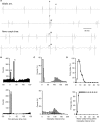Excitability properties of single human motor axons: are all axons identical?
- PMID: 24678291
- PMCID: PMC3958702
- DOI: 10.3389/fncel.2014.00085
Excitability properties of single human motor axons: are all axons identical?
Keywords: axonal excitability recovery; motor control; single firing motor units; superexcitability; voluntary muscle contraction.
Figures

References
-
- Bergmans J. (1970). The Physiology of Single Human Nerve Fibres. Louvain: Vander
-
- Bergmans J. (1973). Physiological observations on single human nerve fibers, in New Developments in Electromyography and Clinical Neurophysiology, Vol. 2, ed Desmedt J. E. (Basel: Karger; ), 89–127
LinkOut - more resources
Full Text Sources
Other Literature Sources

